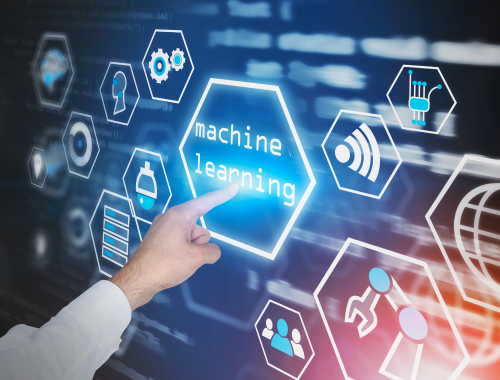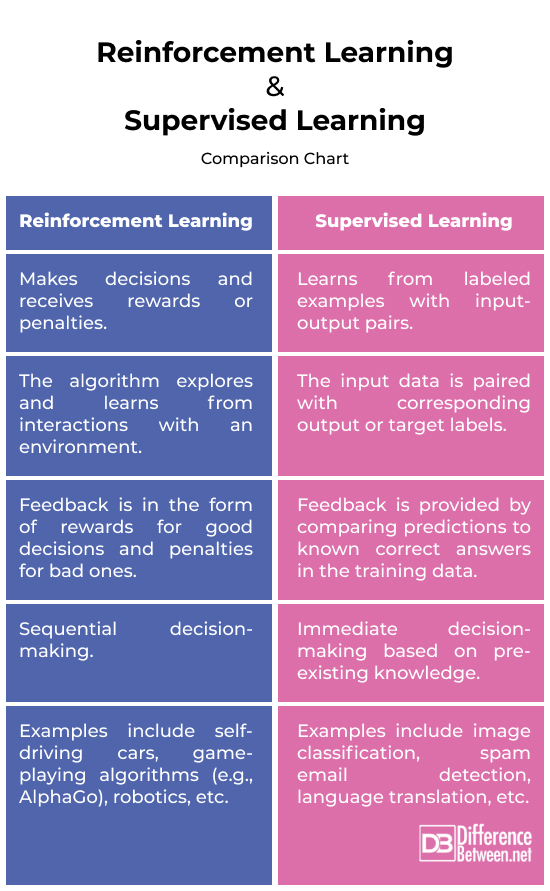Difference Between Reinforcement Learning and Supervised Learning
Machine learning has been used constantly to improve the performance of machines over time. It has become popular because it helps machines or computers learn from data and make decisions without explicit programming. This is like teaching a computer to recognize patterns, like predicting movie preferences or health trends. Now, reinforcement learning and supervised learning are two fundamental areas of machine learning.
This article is a brief introduction to the two areas of machine learning and includes some key concepts associated with them. We also break down the differences between reinforcement learning and supervised learning.

What is reinforcement learning?
Reinforcement learning (RL) in machine learning is like teaching a computer to make decisions by trial and error, just like how we learn from rewards and punishments. It’s the science of decision-making that differs from normal machine learning, as it doesn’t involve training datasets. RL is where an algorithm learns to make decisions by interacting with an environment.
As RL is based on environments, there are many parameters involved. It takes a lot of information to learn and act accordingly.
For example, robots learn how to perform tasks, such as picking up objects or walking, by experimenting with different actions and receiving feedback based on their success or failure. Self-driving cars, for that matter, use reinforcement learning to navigate roads safely.

What is supervised learning?
Supervised learning is a machine learning paradigm where machines are trained using labeled datasets. Then machines predict the output based on the data, which means the input data is paired with corresponding output or target labels. Once the model is trained, you can use it to make predictions or classifications on new, unseen data.
In a movie recommendation system, for example, the input data might be user preferences, and the correct answers would be the movies those users liked.
Supervised learning is widely used in various applications, including natural language processing (NLP), image classification, speech recognition, fraud detection, medical diagnosis, etc.
Difference between Reinforcement Learning and Supervised Learning
- Learning Approach: Reinforcement learning is where an algorithm learns to make decisions by interacting with an environment. It learns through trial and error, making decisions and receiving rewards or penalties based on those decisions. Supervised learning is where machines are trained using labeled datasets, and the machines then predict the output based on the data.
- Decision-Making: In supervised learning, you have both the input and the output for decision-making before you start learning. It’s like having a bunch of practice questions with correct answers to study from. You learn by looking at these examples. Reinforcement Learning is about making decisions step by step, like playing chess. You make a move, and then what happens next depends on that move. So, in a way, you learn as you go based on the outcomes of your decisions.
- Feedback: In reinforcement learning, feedback comes in the form of rewards or punishments. When the algorithm makes a decision, it receives a reward if it’s a good choice and a penalty if it’s a bad one. Supervised learning, on the other hand, receives feedback by evaluating the accuracy of its predictions. It compares what it predicts with the known correct answers in the training data. If there’s a mismatch, it adjusts its internal parameters to reduce errors and improve accuracy.
- Use Cases: Reinforcement learning is used in autonomous driving, where a car must adapt to changing road conditions and make real-time decisions. On the other hand, supervised learning is ideal for tasks with well-defined input-output relationships, such as image recognition or spam email detection.
Other examples of supervised learning are classification and regression. Classification is like sorting things into groups. Regression is about making smart predictions; it helps guess things like future sales or how much a house might cost.
Reinforcement Learning vs. Supervised Learning: Comparison Chart

Summary
Reinforcement Learning is more like playing a game without knowing the rules. The computer interacts with its environment like a player learning to win by trial and error. It’s used in various areas like games, control systems, and decision-making. In supervised learning, the computer uses training data to follow a formula and predict outcomes, similar to solving math problems with answers provided.
FAQs
What is the difference between reinforcement learning and other learning?
Reinforcement learning is different because it learns by making decisions and getting rewards, unlike other types of learning.
Can reinforcement learning be supervised?
Reinforcement learning isn’t supervised; it’s more like learning through trial and error.
What is the main difference between supervised and unsupervised machine learning?
In supervised learning, there are known answers (labels) for the data, while in unsupervised learning, there are no labels.
What is an example of reinforcement learning?
A good example of reinforcement learning is a computer learning to play a game and getting better with practice.
What is the difference between ML and RL?
In machine learning (ML), problems are often divided into smaller parts and solved step by step. Each part is handled separately without thinking too much about the overall goal. Reinforcement learning (RL) is different. It’s all about reaching a big, long-term goal without breaking it into smaller tasks.
- Difference Between Caucus and Primary - June 18, 2024
- Difference Between PPO and POS - May 30, 2024
- Difference Between RFID and NFC - May 28, 2024
Search DifferenceBetween.net :
Leave a Response
References :
[0]Nandy, Abhishek and Manisha Biswas. Reinforcement Learning: With Open AI, TensorFlow and Keras Using Python. Apress, 2017.
[1]Winder, Phil. Reinforcement Learning. O'Reilly Media, 2020.
[2]Castaño, Arnaldo Pérez. Practical Artificial Intelligence: Machine Learning, Bots, and Agent Solutions Using C#. Apress, 2018.
[3]Image credit: https://www.canva.com/photos/MADmeHGEOZs-man-pressing-machine-learning-button/
[4]Image credit: https://www.canva.com/photos/MAELKKh1lGQ-data-analysts-working-on-data-analytics-and-visualization-with-machine-learning-on-computer-screen-in-modern-office-data-science-in-business-finance-and-innovation-/
